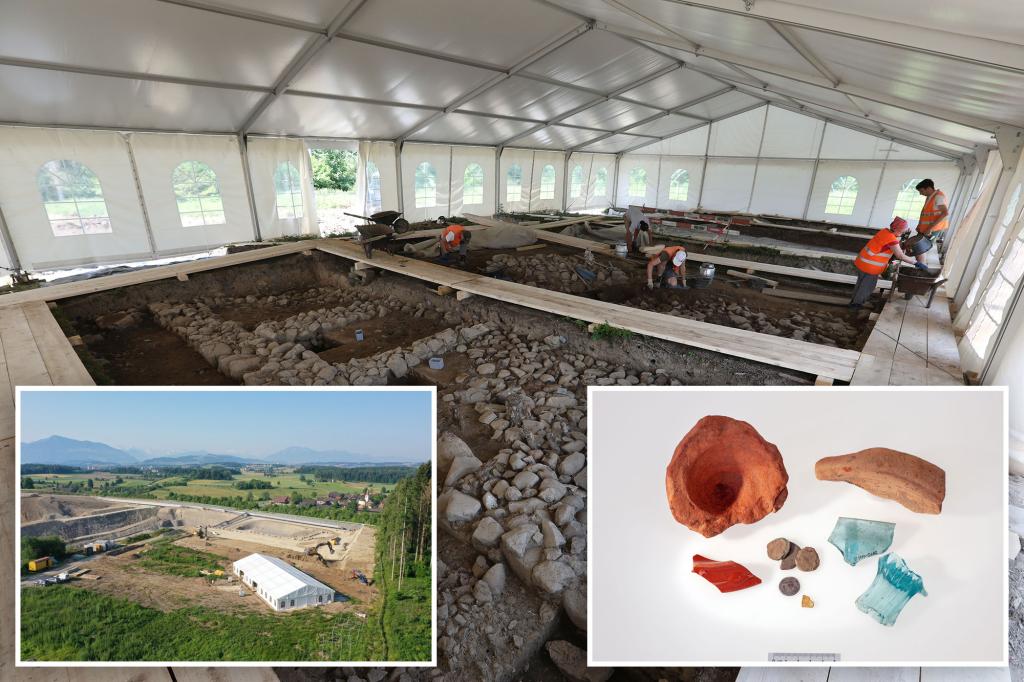A massive 2,000-year-old complex containing a trove of ancient Roman artefacts has been discovered beneath a Swiss gravel quarry — the first such discovery in almost a century.
Archaeologists announced last week that they had slowly and carefully excavated the remains of what was once an “impressive building complex” that had been lying beneath the forest floor in the foothills of the Alps for thousands of years.
The discovery is extremely rare for the country, and it is the first time such a large relic has been found in the area in almost a century.
“Only a few remains of this kind of structure from Roman times are known in the pre-Alpine region – in contrast to other areas. What is impressive is the relatively good preservation of the remains,” said Christa Ebnöther, Professor of Roman Regional Archeology at the University of Bern, in a statement.
Although the complex has yet to be fully discovered, archaeologists estimate that its walls extend over an area of at least 5,300 square feet and contain several rooms.
What the purpose of the monumental building was has yet to be discovered, with scientists questioning whether it was a temple or just a villa that provided stunning views of the mountains and reservoirs that surrounded the area that would later become the quarry.
 An “impressive building complex” was discovered under a gravel quarry in the Swiss Alps. Photo: ADA Zug, David Jecker
An “impressive building complex” was discovered under a gravel quarry in the Swiss Alps. Photo: ADA Zug, David Jecker
Items found so far inside the structure are already giving archaeologists a glimpse into the lives of the ancient Romans who called the Swiss Alps home around 20 AD.
Roman dinner plates — or so-called terra sigillata — and manufactured glass vessels, as well as fragments of gold that may have belonged to a piece of jewelry have already been lifted from the ruins for preservation.
In addition to copper and bronze coins, silver coins of Julius Caesar from the 1st century BC were also found. The face of the coin shows an elephant trampling a dragon or snake.
 A silver coin of Julius Caesar from the 1st century BC was found. Photo: ADA Zug, David Jecker
A silver coin of Julius Caesar from the 1st century BC was found. Photo: ADA Zug, David Jecker
 Archaeologists found an amphora base, a mortar fragment, the rim of a small bowl of red-coated Roman crockery, four coins, fragments of a gold object, a piece of a square bottle and a bowl lined with blue glass. Photo: ADA Zug, David Jecker
Archaeologists found an amphora base, a mortar fragment, the rim of a small bowl of red-coated Roman crockery, four coins, fragments of a gold object, a piece of a square bottle and a bowl lined with blue glass. Photo: ADA Zug, David Jecker
 Archaeologists estimate that the wall spanned at least 5,300 square feet and contained several rooms. Photo: ADA Zug, David Jecker
Archaeologists estimate that the wall spanned at least 5,300 square feet and contained several rooms. Photo: ADA Zug, David Jecker
“Fragments of amphorae, in which, among other things, wine, olive oil and fish sauce from the Mediterranean region to the Äbnetwald near Cham, bear witness to the extensive trade of the Roman period,” the Office of the Preservation of Monuments and Archeology stated in a release.
“A large number of iron nails speak for wood construction on an existing wall foundation.”
Although valuable relics from various peoples have been found in the area in recent decades – including the remains of settlements from the Middle Bronze Age, graves from the late Bronze Age and numerous coins from the Celtic era – ruins from ancient Rome are a rare find in the Alps. .
 Archaeologists have been excavating the building since first discovering the ruins in early 2023. Photo: ADA Zug, David Jecker
Archaeologists have been excavating the building since first discovering the ruins in early 2023. Photo: ADA Zug, David Jecker
Archaeologists have been systematically excavating the stone building since parts of the remains were first seen poking out of the ground earlier this year.
After a thorough inspection, they will remove the walls for the interior of the house which is safer to preserve.
Before that, however, the public will be invited to see the ruins and archaeologists in action next week and learn from professionals what lessons the remains can teach.
“These pieces of the puzzle make it possible to trace the lives of our ancestors and to better understand our history,” said Karin Artho, head of the Monuments and Archeology Preservation Office.
Categories: Trending
Source: thtrangdai.edu.vn/en/



